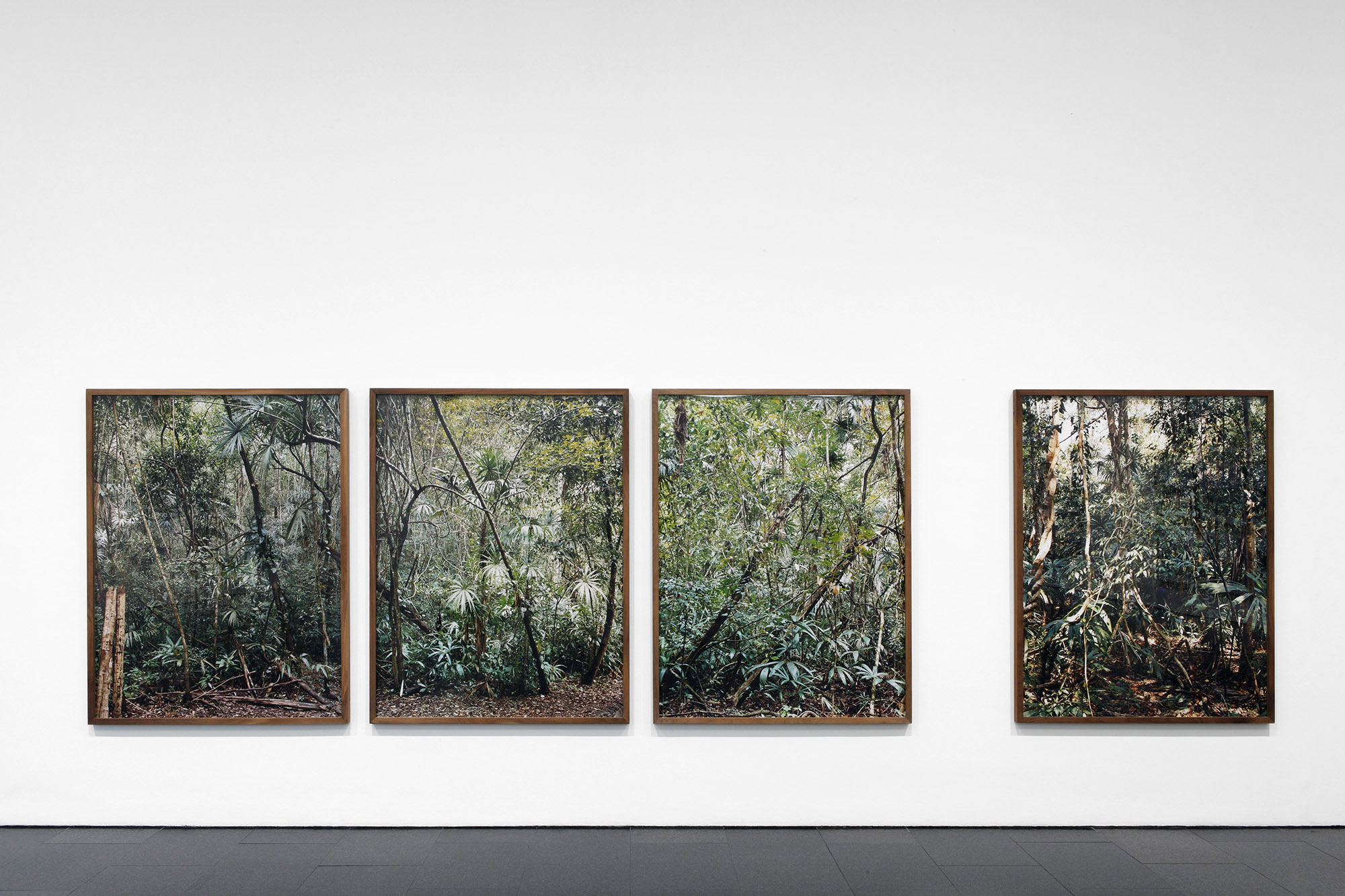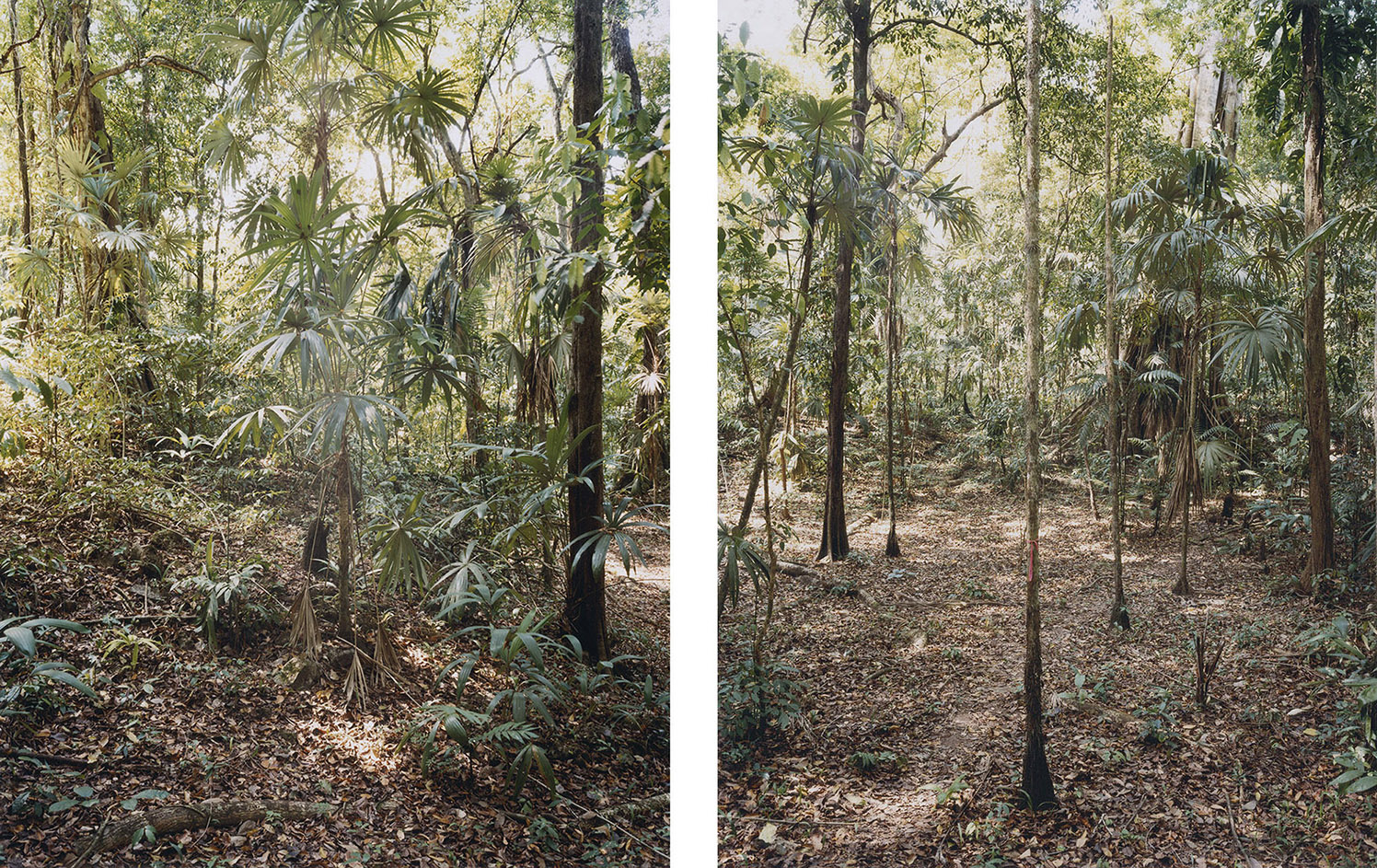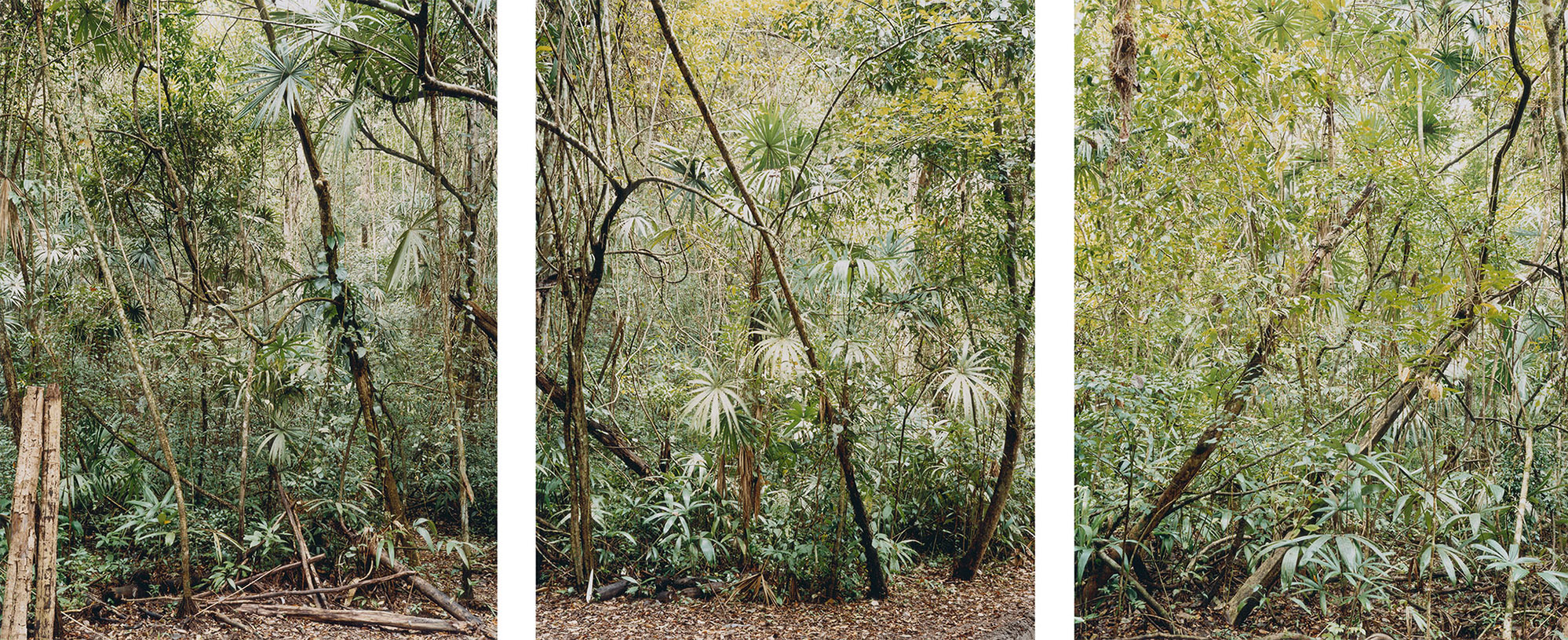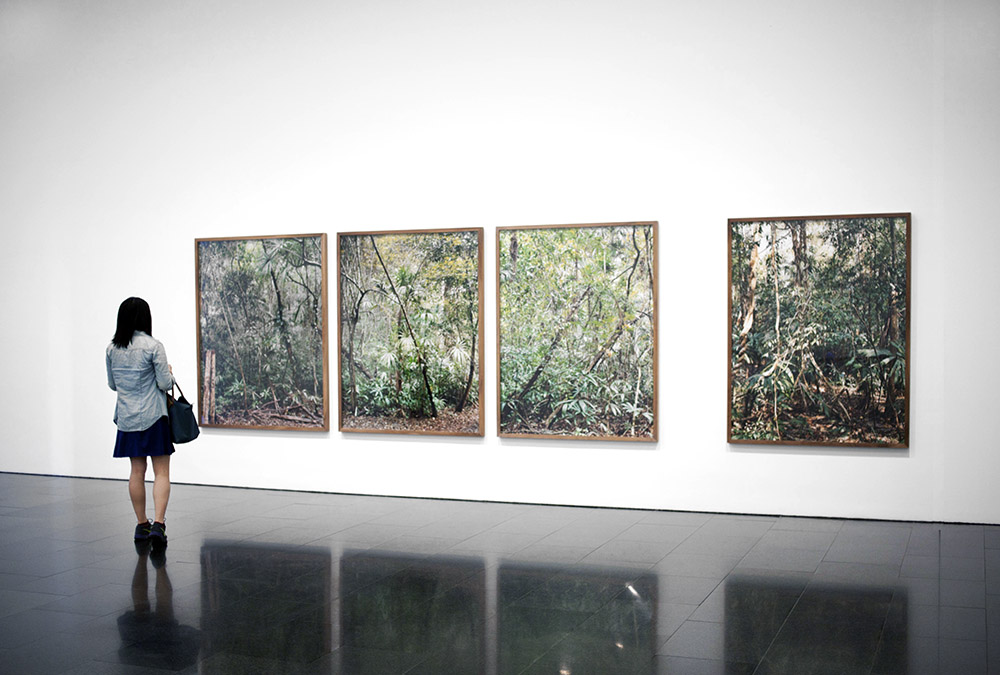© XAVIER RIBAS - Invisible Structures [1] (2006) 15 C-Type prints size 120 x 155 cm. Edition of 6

Invisible Structures I (2006). Installation Museu d'Art Contemporani de Barcelona, 2014 [Installation photograph: Marc Roig]
[En]
"One is always crossing the horizon, yet it always remains distant."
Robert Smithson
These images represent tangled fragments of jungle, with no horizon, discontinuous, indifferent, interchangeable. These images 'bursting with jungle' represent the edges of archaeological excavations, they look outwards, trying to capture an unconstructed space. At first glance, these images make us think of a wild space, natural, undefined, as if without motif. However, this disorganized and entropic space is, in fact, a historical site, the site of an ancient Maya city buried beneath the rainforest floor.
The sprawl of this ancient Maya city, made up of 'squares' (plazas), roads and common residential structures, is of secondary archaeological interest compared to its ceremonial centres and elite residential compounds, and it tends to remain unexcavated, deep in the rainforest floor, estranged from the work of archaeological documentation and historical interpretation that begins exploring from the center. This 'periphery' of the city, and in a sense of archaeology, or of history, is the subject of these photographs.
Paradoxically, the presence of this historical memory of the pre-Columbian Maya civilization can be perceived more intensely in its overgrown invisibility than in the reconstructed spaces of the archaeological parks, which are somehow disappointing in their inevitable similarity to the character and aesthetics of theme parks. The archaeological parks tend to be spaces designed with an urban mentality and for tourism (entrance fees, souvenirs, toilets, picnic and rest areas, etc). In the rainforest, however, the perception of something that is hidden gives us a better framework to appreciate this historical presence. The mounds which denote buried ceremonial or residential structures, and which could be perceived at first glance as 'small jungle-covered hills'; the distances between them concertinaed by an impenetrable vegetation; the traces left by the archaeological excavations, now filled in, the earth less densely packed, mediate more effectively than the reconstructed landscapes and monuments of the archaeological parks. The images here propose that we approach this historical site not from the point of view of the visible, but through the perception of an absence.
The memory that is represented here is not the monument, but a projection, a threshold, a memory 'which is not yet', or that is as yet 'unthought', as in a state of 'inversion' (Robert Smithson). Or, a memory which, simply, does not let itself be thought, as if the rainforest was not only the direct consequence of the desolation and the crumbling of a civilization, but also the necessary strategy for the preservation of its fragments: we could say that it hides itself, that it buries itself and that it eludes us.
---
[Cast] Las imágenes representan fragmentos enmarañados de selva, sin horizonte, indiferentes, intercambiables. Estas imágenes ‘llenas de selva’ representan el límite de excavaciones arqueológicas, miran como hacia afuera, queriendo aprehender un espacio sin construir. A primera vista, las imágenes nos inducen a pensar en un espacio salvaje, natural, indefinido, como sin motivo. Sin embargo, este espacio desordenado y entrópico es, en realidad, un lugar histórico, es el lugar de una ciudad Maya oculta bajo el manto de la selva.
Ese ámbito urbano, de plazas, caminos y estructuras residenciales comunes, tiene un interés arqueológico menos apremiante que los centros ceremoniales o residenciales de élite, y suele quedar sin excavar, en la selva, ajena al trabajo de ordenación e interpretación histórica de la arqueología que empieza excavando desde el centro. Esta ‘periferia’ de la ciudad, y en cierto modo de la arqueología, o de la historia, es el objeto de estas fotografías.
Paradójicamente, la presencia de esta memoria histórica de la civilización maya precolombina se puede percibir mas intensamente en su invisibilidad selvática que en los espacios reconstruidos de los parques arqueológicos, los cuales, de alguna manera, decepcionan por su inevitable similitud en estética y carácter con los parques temáticos. Los recintos arqueológicos suelen ser espacios pensados con una mentalidad de ciudad y una funcionalidad turística (taquilla, souvenirs, aseos, etc). En la selva, sin embargo, la percepción y la intuición de este ocultamiento nos ofrece un marco más idoneo para aprehender esta presencia histórica. Los montículos que denotan estructuras ceremoniales o residenciales enterradas, y que a simple vista parecen ‘pequeñas colinas cubiertas de selva’, las equidistancias abarrotadas de una vegetación impenetrable, las huellas de las prospecciones arqueológicas ya tapadas, cuya tierra removida ha perdido densidad y consistencia, ofrecen un campo de mediación mucho más eficaz que los paisajes y los monumentos reconstruidos de los parques arqueológicos.
Las imágenes proponen encarar este lugar histórico no a partir de lo visible y lo ordenado, sino a partir de la ‘suspensión’ temporal y espacial de su materialidad histórica. La memoria que se representa en estas imágenes no es el monumento, sino una proyección, un umbral, una memoria ‘que no lo es todavía’, o que está ‘sin pensar’, como en un estado de ‘inversión’ (Robert Smithson). O una memoria que, simplemente, no se deja pensar, como si la selva no solamente fuera la consecuencia directa de la desolación y del desmoronamiento de una civilización, sino también la estrategia necesaria para la preservación de sus fragmentos: diríamos que se oculta, que se entierra y que nos elude.
© Xavier Ribas (2008)
THis work was comissioned by Photo España and produced with the support from the Fonds National d'Art Contemporain, France.
The photographs were taken in the remote archaeological site of Waka', Reserva de la Biosfera Maya, Petén Department, Guatemala, in March 2006. The author would like to acknowledge the collaboration and help of the Proyecto Arqueológico Waka', directed by David Freidel (Southern Methodist University, Dallas) and Héctor Escobedo (Universidad San Carlos, Guatemala), and especially of the project archaeologists: David Lee, Damien Marken, Griselda Pérez, Jennifer Piehl, Varinia Matute, Fabiola Quiroa, Michelle Rich, Laura Gámez, Juan Carlos Meléndez, Ana Lucia Arroyave, Juan Carlos Ramírez, Olivia Farr and Keith Eppich. Thanks also to Tomás Barrientos (Universidad del Valle, Guatemala), Martín Asturias and Arturo Godoy.
---

Invisible Structures I #1 to 15

Invisible Structures I #4 and 5 [diptych]

Invisible Structures I #6, 7 and 8 [triptych]

+
Related files
Fietta Jarque, "La Rebelión del Paisaje". In Babelia / El País 20/09/2008 [Cast]
Nieves Fontova, Entrevista a Xavier Ribas. Published in Diario Vasco, Junio 2006 [Cast]
Exhibition review, Invisible Structures, Belfast Exposed. Published in Source, Issue 49 Winter 2006, Belfast [En]
PDF Lluís Sabadell i Artiga, Invisible Landscapes / Impossible Places. Espai Zero, Girona 2007 [En] [Cast] [Cat]
Pedro Leão Neto, "Invisble Structures: Representing a Memory that Hasn't Yet Been Imagined". Scopio International Photography Magazine, No. 3, Porto 2013 [En]
PDF
Press release Nou-Now. Contemporary Catalan Photography, FFi - Fotografie Forum international, Frankfurt [En]
PDF
Press release Del Paisaje Reciente, Fundación ICO, Madrid [Cast]
PDF
Press release Invisible Structures, ProjecteSD, Barcelona [En]